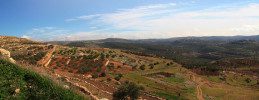 |
| the region of Samaria, courtesy, Shalom Israel Tours |
Under Herod, the city of Samaria became the capital of the district of Samaria, the city itself being known as Sebaste, the Greek equivalent of the Latin "Augusta", so named in honor of Augustus Cæsar. Josephus speaks of the soldiers of Sebaste who served in the army of the House of Herod and who later sided with the Romans resulting in the city being attacked by Jews at the outbreak of the war against Rome. Sebaste is also mentioned in the Mishnah where its orchards are praised. Jerome, an early Christian and church father, records the tradition that the city was the burial-place of the prophets Elisha and Obadiah, as well as of John the Baptist. However, during the Crusader occupation, the 12th century Jewish traveler from Spain, Benjamin of Tudela, does not relate to these tombs at all but states only that traces of the palace of King Ahab of Israel were still visible, and that in his day, he found no Jewish community in the city. Beginning in 1931, a major international archaeological expedition there involved Professor Eliezer Sukenik of the Hebrew University who worked conjointly with John Winter Crowfoot of the British School of Archaeology in Jerusalem and Kathleen Kenyon of the Palestine Exploration Fund.
Since the Crusader occupation, the region
of Samaria played a significant part in the history of the Jews in Israel.
Shechem was home to an ancient Jewish community as well as a Samaritan
community. The Jewish community waxed and waned over the centuries depending on
the security situation. The same with the town of Anin near Umm el Fahm.
In the 18th and 19th centuries, the Turkish authorities
settled Arab migrants from Yemen in Anin which eventually drove the Jews away.
In 1831, the Arab settlers of the region in
and around the fortress of Sanur had
rebelled against the rule of Abdalla Pasha. A renowned band of Jewish warriors
from the Lebanon were called to subdue the rebellion which they did
successfully, and the Pasha ordered the fortress and town levelled to the
ground, in which state they remained for many years afterward. Later, an Arab
settlement was built on the site. By the late 70s, a Jewish community was
established adjacent to the Arab settlement.
In c. 1904, the last Jews left Shechem,
fleeing from the high taxes that were imposed only on Jews. The Samaritan
presence remained constant (see Mount Gerizim). In nearby Awarta, a
Jewish community had long ago sprung up but was expelled by the Arabs in 1912. By
the beginning of the British Mandatory period, the city of Tulkarm had a small Jewish population in the midst of a majority
Arab population. In 1925, an agricultural
school was established there by a Jewish businessman from China, Sir Ellis
Kadoorie, specifically to teach the local Arabs modern methods in farming. The
later Arab riots throughout the country ethnically cleansed Tulkarm of its
Jews.
During the War of Independence in 1948,
Samaria came under Arab occupation, remaining so until liberated by Israel in
1967. The Samaritans were left alone but, since the Israeli army and government
were led by Zionists, Jews were banned from returning to the area. After
several attempts to reestablish a Jewish community in the town of Samaria, a
compromise was reached and the Jews were given land at the army base at nearby
Kadum. A community was established and the town of Kedumim came into being – the first Jewish town in the Samaria
region since Biblical times. Kedumim was soon followed by other towns throughout
Samaria: Elkana, Reihan, Sal’it, Shavei
Shomron, Ariel (which grew into a city of some 20,000 and was designated
the capital of Samaria), Karnei Shomron,
Sanur, Kfar Tapuah, Mevo Dotan, Elon
Moreh (where Abraham first rested upon entering the Promised Land), and
many others. During the so-called “Second Intifada”, the entire Samaritan community
in Shechem was forced by the Arabs to move out. They settled in the nearby village
of Kiryat Luza, built for them by
the Israeli government. Today, the closest to Shechem the Arabs and Zionists
will allow a Jew or Samaritan, are in the Jewish community of Har Bracha and the Samaritan community
of Kiryat Luza. Both lie on top of Mount Gerizim just outside, and overlooking,
the city. Meanwhile, the community of Sanur, along with 3 others including Homesh, was violently ethnically
cleansed in 2005 by the Zionists led by Ariel Sharon. Soon after, Homesh became
a flashpoint in the effort to rebuild these illegally destroyed communities.
The many Jewish holy sites in Samaria had
been places of Jewish pilgrimages for thousands of years (access now severely
restricted by the Zionists): the Tomb of
Joseph in Shechem; the Tombs of
Eleazar and Ittamar in Awarta; the Tombs
of Joshua and his father Nun and the Tomb
of Caleb in Kifl Hares; the Tomb of the High Priest Eli in Shiloh. The Samaria National Park was created by the Israeli government (!) and
is today under authority of the Israel Nature and Parks Authority. It is
considered to be the largest national park in Israel today.
In 2014, the first “Bible Marathon”
took place in Samaria, stretching the mandated 26 miles, from Rosh Haayin to Shiloh. It follows the
path taken in Biblical times when a messenger went from the site of Israel’s
defeat at the hands of the Philistines (today Rosh Haayin) to the High Priest
Eli in Shiloh. It was the first recorded marathon in history, predating the
Greek.
No comments:
Post a Comment